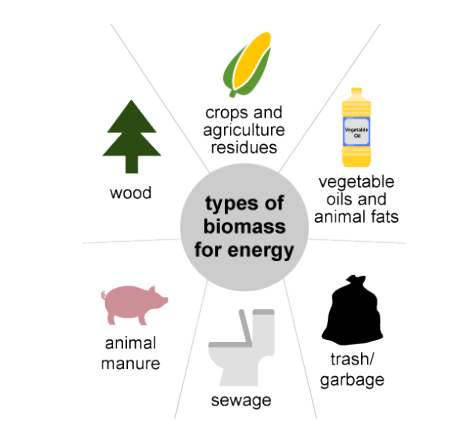Renewable-energy / Renewable Energy / Biomass Energy

- Biomass is renewable organic material that comes from plants and animals. Biomass continues to be an important fuel in many countries, especially for cooking and heating in developing countries. The use of biomass fuels for transportation and for electricity generation is increasing in many developed countries as a means of avoiding carbon dioxide emissions from fossil fuel use.
- Biomass contains stored chemical energy from the sun. Plants produce biomass through photosynthesis. Biomass can be burned directly for heat or converted to renewable liquid and gaseous fuels through various processes.
- Biomass sources for energy include:
- Wood and wood processing wastes—firewood, wood pellets, and wood chips, lumber and furniture mill sawdust and waste, and black liquor from pulp and paper mills
- Agricultural crops and waste materials—corn, soybeans, sugar cane, switchgrass, woody plants, and algae, and crop and food processing residues, mostly to produce biofuels
- Biogenic materials in municipal solid waste—paper, cotton, and wool products, and food, yard, and wood wastes
- Animal manure and human sewage for producing biogas/renewable natural gas
- Biomass is converted to energy through various processes, including:
- Direct combustion (burning) to produce heat
- Thermochemical conversion to produce solid, gaseous, and liquid fuels
- Chemical conversion to produce liquid fuels
- Biological conversion to produce liquid and gaseous fuels
Advantages
- Biomass is always and widely available as a renewable source of energy
- It is carbon neutral.
- It reduces the overreliance of fossil fuels.
- Is less expensive than fossil fuels.
- Biomass production adds a revenue source for manufacturers.
- Less garbage in landfills.
Disadvantages
- Biomass energy is not as efficient as fossil fuels
- It is not entirely clean
- Can lead to deforestation.
- Biomass plants require a lot of space.
Biomass Energy Potential in India
- About 32% of the total primary energy use in the country is still derived from biomass and more than 70% of the country’s population depends upon it for its energy needs.
- Ministry of New and Renewable Energy has realised the potential and role of biomass energy in the Indian context and hence has initiated a number of programmes for promotion of efficient technologies for its use in various sectors of the economy to ensure derivation of maximum benefits. For efficient utilization of biomass, bagasse based cogeneration in sugar mills and biomass power generation have been taken up under biomass power and cogeneration programme.
- Biomass power & cogeneration programme is implemented with the main objective of promoting technologies for optimum use of country’s biomass resources for grid power generation. Biomass materials used for power generation include bagasse, rice husk, straw, cotton stalk, coconut shells, soya husk, de-oiled cakes, coffee waste, jute wastes, groundnut shells, saw dust etc.
- As per a recent study sponsored by MNRE, the current availability of biomass in India is estimated at about 750 million metric tonnes per year. The Study indicated estimated surplus biomass availability at about 230 million metric tonnes per annum covering agricultural residues corresponding to a potential of about 28 GW. This apart, about 14 GW additional power could be generated through bagasse based cogeneration in the country’s 550 Sugar mills, if these sugar mills were to adopt technically and economically optimal levels of cogeneration for extracting power from the bagasse produced by them.
- As on 31.10.2022, a total capacity of 10205.61 MW has been installed in Biomass Power and Cogeneration Sector.
- Installed Capacity of Biomass IPP – 1871.11 MW
- Installed Capacity of Bagasse Cogeneration – 7562.45 MW
- Installed Capacity of Non-Bagasse Cogeneration - 772.05 MW

